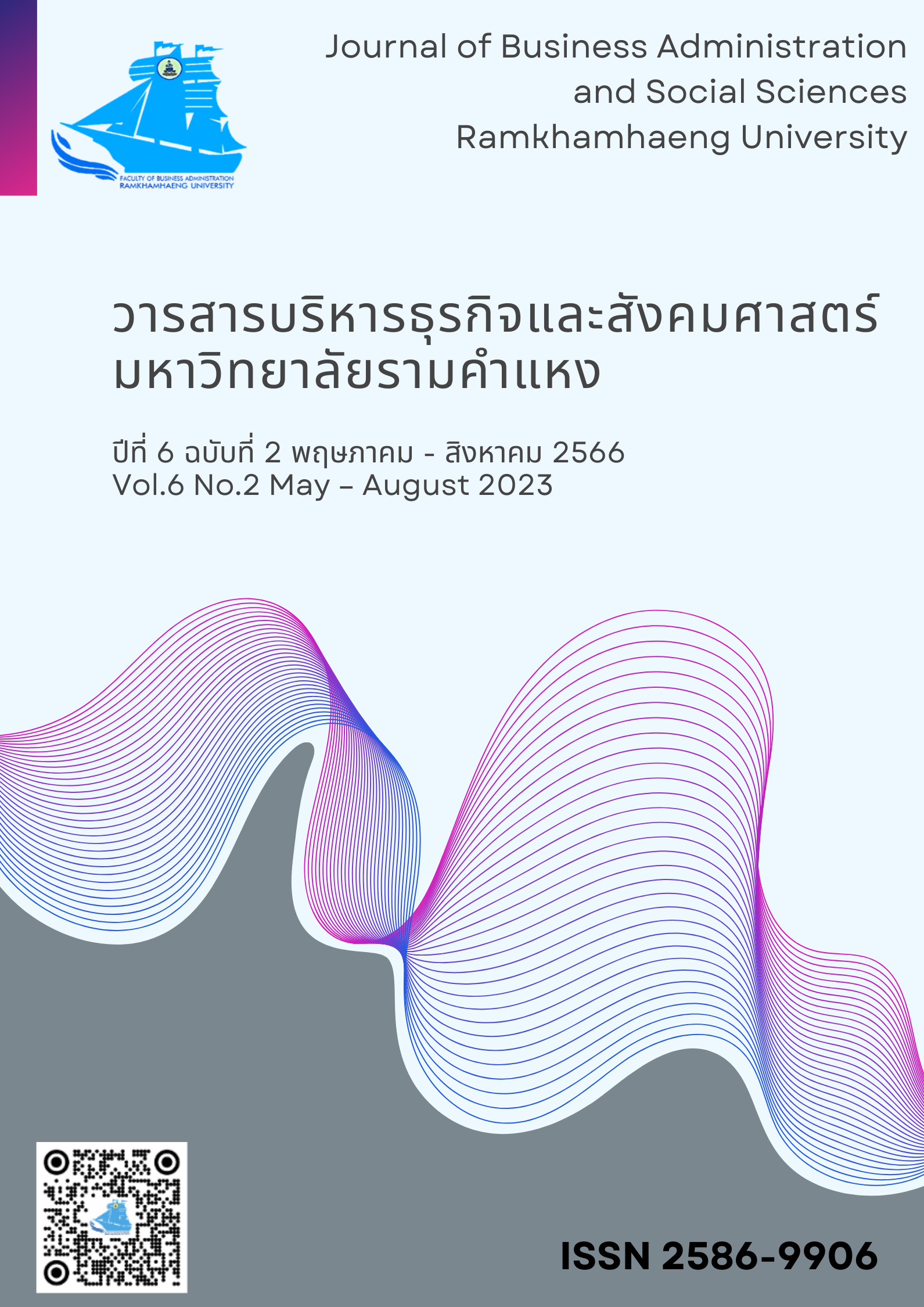Personalization: Introduction, Applications, Concerns, and Recommendations
Main Article Content
Abstract
Today, online businesses often offer personalized services to consumers. Personalization not only gives consumers better experience, but also helps increase businesses profitability. However, there are some drawbacks that come with it. This article aims to provide basic knowledge of web personalization and its impacts. There are four parts presented in the article as follows: 1) basic knowledge of personalization, from consumer data collection to how data is used in various types of recommender systems; 2), give examples of how personalization is used – that is, in advertising, user engagement, and product recommendation; 3) discuss the impacts of personalization on consumers and society – consumer privacy concerns and a decrease in content diversity; and 4) recommendations to stakeholders – businesses, consumers, and government agencies.
Article Details

This work is licensed under a Creative Commons Attribution-NonCommercial-NoDerivatives 4.0 International License.
เนื้อหาและข้อมูลในบทความที่ลงตีพิมพ์ในวารสารบริหารธุรกิจและสังคมศาสตร์ มหาวิทยาลัยรามคำแหง ถือเป็นข้อคิดเห็นและความรับผิดชอบของผู้เขียนบทความโดยตรง ซึ่งกองบรรณาธิการไม่จำเป็นต้องเห็นด้วย หรือร่วมรับผิดชอบใดๆ
บทความ ข้อมูล เนื้อหา รูปภาพ ฯลฯ ที่ได้รับการตีพิมพ์ในวารสารบริหารธุรกิจและสังคมศาสตร์ มหาวิทยาลัยรามคำแหง ถือเป็นลิขสิทธิ์ของวารสารบริหารธุรกิจและสังคมศาสตร์ มหาวิทยาลัยรามคำแหง หากบุคคลหรือหน่วยงานใดต้องการนำบทความทั้งหมดหรือส่วนหนึ่งส่วนใดไปเผยแพร่ต่อ หรือเพื่อกระทำการใดๆ จะต้องได้รับอนุญาตเป็นลายลักษณ์อักษรจากวารสารบริหารธุรกิจและสังคมศาสตร์ มหาวิทยาลัยรามคำแหง ก่อนเท่านั้น
References
กระทรวงดิจิทัลเพื่อเศรษฐกิจและสังคม. (2565). รายงานผลการสำรวจพฤติกรรมผู้ใช้อินเทอร์เน็ตใน
ประเทศไทย ปี 2565. สืบค้นจาก https://www.etda.or.th/getattachment/78750426-4a58-4c3685d3d1c11c3db1f3/IUB-65-Final.pdf.aspx
สำนักงานคณะกรรมการกฤษฏีกา. พระราชบัญญัติคุ้มครองข้อมูลส่วนบุคคล. 2562 (พฤษภาคม, 27)
Anand, S. S., & Mobasher, B. (2005). Intelligent Techniques for Web Personalization. Springer
Heidelberg, LNAI (169), DOI:10.1007/11577935_1
Bodó, B., Helberger, N., Eskens, S., & MöllerInterested, J. (2019). Interested in Diversity: The
role of user attitudes, algorithmic feedback loops, and policy in news personalization.
Digital Journalism, 7(2), 206-229, DOI: 10.1080/21670811.2018.1521292
Bol, N., Dienlin, T., Kruikemeier, S., Sax, M., Boerman, C. S., Strycharz, J. Helberger, N., &
Vreese, H. C. (2018). Understanding the Effects of Personalization as a Privacy Calculus:
Analyzing Self-Disclosure Across Health, News, and Commerce Contexts. Journal of
Computer-Mediated Communication, 23, 370–388. DOI:10.1093/jcmc/zmy020
Bozdag, E. (2013). Bias in algorithmic filtering and personalization. Ethics and Information
Technology, 15, 209-227. DOI: 10.1007/s10676-013-9321-6
Das, A. S., Datar, M., Garg, A., & Rajaram, S. (2007). Google news personalization: scalable
online collaborative filtering. Proceedings of the 16th international conference on World Wide Web (pp. 271-280).
de Pechpeyrou, P. (2009). How consumers value online personalization: a longitudinal
experiment. Direct Marketing: An International Journal, 3(1), 35-51.DOI:10.1108/17505930910945723
Dubois, E., & Blank, G. (2018). The echo chamber is overstated: the moderating effect of
political interest and diverse media. Information, Communication & Society, 21(5), 729
DOI:10.1080/1369118X.2018.1428656
Eirinaki, M., & Vazirgiannis, M. (2003). Web Mining for Web Personalization. ACM Transactions
on Internet Technology, 1(3), 1-27. DOI:10.1145/643477.643478
Fleder, D., & Hosanagar, K. (2009). Blockbuster Culture's Next Rise or Fall: The Impact of
Recommender Systems on Sales Diversity. Management Science, 55(5), 697-712.
DOI:10.1287/mnsc.1080.0974
Google.com (2022, December 15). Google privacy policy. [Press release]. Retrieved from
https://policies.google.com/privacy
Guo, X., Sun, Y., Ziyu, Y., & Nan, W. (2012). Privacy-Personalization Paradox in Adoption of
Mobile Health Service: The Mediating Role of Trust. PACIS 2012 Proceedings, 27-42.
Retrieved from https://aisel.aisnet.org/pacis2012/27/
Helberger, N., Karppinen, K., & D’Acunto, L. (2018). Exposure diversity as a design principle for
recommender systems. Information, Communication & Society, 21(2), 191-207.
DOI: 10.1080/1369118X.2016.1271900
Kalaignanam, K., Kushwaha, T., & Rajavi, K. (2018). How Does Web Personalization Create
Value for Online Retailers? Lower Cash Flow Volatility or Enhanced Cash Flows. Journal
of Retailing, 94(3), 265–279. DOI: 10.1016/j.jretai.2018.05.001
Koene, A., Perez, E. J., Carter, J. C., Statache, R., Adolphs, S., O’Malley, C., Rodden,
T., & McAuley, D. (2015). Privacy concerns arising from Internet service personalization
filters. Durham Research Online, 45(3), 167-171. DOI:10.1145/2874239.2874263
Möller, J., Trilling, D., Helberger, N., & van Es, B. (2018). Do not blame it on the algorithm: an
empirical assessment of multiple recommender systems and their impact on content
DOI:10.1080/1369118X.2018.1444076
Mulvenna, M.D., Anand, S.S., & Büchner, A.G. (2000). Personalization on the Net using Web
Mining. Communications of The ACM. 43(8), 122-125. DOI: 10.1145/345124.345165
Nguyen, T. T., Hui, P. M., Harper, F. M., Terveen, J., & Konstan, A. J. (2014). Exploring the Filter
Bubble: The Effect of Using Recommender Systems on Content Diversity. The
International world wide web conference committee (IW3C2), 677–686.
DOI:10.1145/2566486.2568012
Noor, U., Mansoor, M., & Shamim, A. (2022). Customers Create Customers!–Assessing the role
of perceived personalization, online advertising engagement and online users' modes in
generating positive e-WOM. Asia-Pacific Journal of Business Administration, Vol. ahead
of print No. ahead-of-print. https://doi.org/10.1108/APJBA-11-2021-0569
Pariser, E. (2011). The fitter bubble: What the internet Is hiding from you. New York: The
Penguin Press
RSA. (2019). RSA Data Privacy and Security Survey 2019: The growing data disconnect
Between consumers and businesses.https://www.rsa.com/content/dam/en/misc/rsa-data
privacy-and-security-survey- 2019.pdf
Salonen, V., & Karjaluoto, H. (2016). Web Personalization : The State of the Art and
Future Avenues for Research and Practice. Telematics and Informatics, 33(4), 1088-
DOI: 10.1016/j.tele.2016.03.004 Schwartz, B., & Ward, A. (2004). Doing better but feeling worse: The paradox of choice. John
iley & Sons, Inc. DOI:10.1002/9780470939338.
Schwartz, K. M. (2019). The personalization–privacy paradox explored through a privacy
calculus model and hofstede’s model of cultural dimensions. Honors Projects, 97
Stevenson, D., & Pasek, J. (2015). Privacy Concern, Trust, and Desire for Content
Personalization. Information and Internet Policy Paper. DOI: 10.2139/ssrn.2587541
Thurman, N., Moeller, J., Helberger, N., & Trilling, D. (2019). My Friends, Editors, Algorithms,
and I: Examining audience attitudes to news selection. Digital Journalism, 7(4), 447-469.
DOI: 10.1080/21670811.2018.1493936
Treiblmaier, H., Madlberger, M., Knotzer, N., & Pollach, I. (2004). Evaluating Personalization and
Customization from an Ethical Point of View: An Empirical Study. 37th Annual Hawaii International Conference on System Sciences, 1-10. DOI:10.1109/HICSS.2004.1265434
Yu, H. J. (2011). Is it worth it to be unethical? Consumers’ attitudes toward personalized
commercial emails. Journal of Database Marketing &Customer Strategy Management, 18, 274–285. DOI: 10.1057/dbm.2011.38
Zhang, R., Jun, M. & Palacios, S. (2023). M-shopping service quality dimensions and their
effects on customer trust and loyalty: an empirical study. International Journal of Quality & Reliability Management, 40(1). 169-191. DOI:10.1108/IJQRM-11-2020-0374


